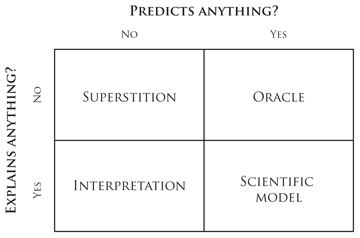Scientific models
By Guillaume Filion, filed under
science,
model,
dialogue.
• 01 January 2020 •
Literature discussions were usually very quiet in the laboratory, but somehow, this article had sparked a debate. Linda thought it was very bad. Albert liked it very much. Kate, the PI, was undecided. At some point the discussion stalled, so Kate made a move to wrap up.
“So, Linda, why do you think the article is bad?”
“Because they are missing a thousand controls.”
“OK. Albert, why do you like this article?”
“I find their model in figure 6 really cool. Actually, if it is true, it…”
“Precisely my point!” interrupted Linda. “It’s pure speculation!”
Kate intervened.
“Albert, you describe figure 6 as a model. What makes it a model?”
Albert spoke after a pause.
“It’s an idealized summary of their findings.”
“Fantasized you mean!” replied Linda.
Kate ignored the point and turned to Linda.
“Linda, do you think that figure 6 is a model?”
“Of course not! It’s just speculation.”
“Now I have a question for you Albert: what is the difference between a model and a summary?”
While Albert was thinking, Kate continued.
“And I also have a question for you Linda: what is the difference between speculation and assumption?”
Now they were quiet. Albert and Linda obviously needed time to think about Kate’s questions.
“It seems that you both use the word model in a different way. It would be good that we all use the same definition in the laboratory. If you don’t mind, I will offer mine.”
Kate took a pen and drew the matrix below.

“But there is no superstition in science”, objected Albert.
“Really? You’ll be surprised how often we use terms that do not explain anything and do not predict anything just because they are ill-defined or overused. Think of words like sustainable or consciousness.”
“I never thought about it this way”, confessed Albert.
“New and controversial concepts can sometimes linger in the the no-no corner, but overall I agree with you Albert: there is no space for superstition in science. More interesting are oracles, or ideas that do not explain anything but from which we can make clear predictions.”
“You mean, like neural networks and machine learning?” asked Linda.
“Precisely. But there is more to it because many so-called theories are in this category. For instance, Darwin criticized creationism not for being impossible to test, but for not explaining anything. According to Creationists of the time, the body plan of animals is symmetric due to a divine principle of symmetry. All it takes to reject the theory is one asymmetric animal, so there is no particular problem from this perspective. The issue is that “divine principle” is a blanket term disconnected from the rational discourse.”
“Then, do you mean that neural networks are bad?” asked Linda.
“I just mean that it is important to remember that they are different from scientific models, and their popularity or success cannot change it. Next on the list are ideas that do not predict anything but still give good explanations. Let us call them interpretations.”
“What is wrong with interpretations?” asked Albert.
“Nothing. We need to interpret scientific results all the time.”
“Then I don’t see how they are so different from models.”
“Some ideas are not meant to be generalized. For instance, historians use evidence to find a plausible scenario, but this is usually a one-off. The short-term goal is not to make predictions about the future. Likewise, a graphical summary makes it easier to read an article, but the goal is rarely to make predictions, at least in biology. A scientific model is something that turns a well-defined set of hypotheses into a well-defined set of predictions. This is quite difficult and for this reason scientific models are actually rare.”
“Can you give us an example of scientific model then?” asked Linda.
“One of the most emblematic models of biology is the theory of natural selection. The hypotheses are very clear (individuals compete for reproduction and mutations are heritable) and so are the predictions (the fittest individuals take over the population). More importantly, the connection is completely transparent: it is impossible to disagree with the logic. What makes scientific models valuable is that they make it easy to see what is wrong with your assumptions (whenever there is something wrong with them).”
“So, is figure 6 a model? asked Albert.”
“Well, this is another story...”
« Previous Post | Next Post »
blog comments powered by Disqus

